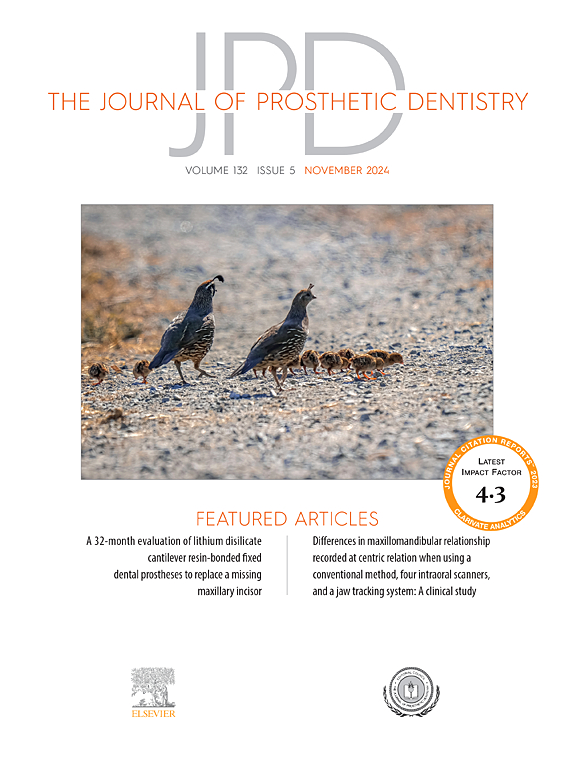制作方法对可摘局部义齿制作精度和内部差异的影响:一项系统回顾和荟萃分析。
IF 4.3
2区 医学
Q1 DENTISTRY, ORAL SURGERY & MEDICINE
引用次数: 0
摘要
问题陈述:可摘局部义齿(rpd)可以用常规铸造工艺或计算机辅助设计和计算机辅助制造(CAD-CAM)技术制造;然而,这些制造方法之间的制造精度和内部差异仍然不确定。目的:本系统综述和荟萃分析的目的是评估制造方法(铸造、铣削或增材制造)对rpd精度和内部差异的影响。材料和方法:在PubMed/Medline、Embase、Web of Science、Scopus、Cochrane和Google Scholar 6个数据库中进行文献电子检索。评估精度和内部差异的研究从铸造,铣削,和增材制造制造的rpd包括在内。报告差距(平均值)和标准偏差的研究纳入meta分析。采用漏斗图不对称和Egger检验确定发表偏倚。结果:共纳入25篇文献。增材制备的rpd内部误差范围为14.4 ~ 511 μm,常规制备的rpd内部误差范围为7 ~ 419 μm。对于铣削方法,有20 ~ 66 μm的水平误差和17 ~ 59 μm的垂直误差。Egger检验表明纳入meta分析的研究中没有发表偏倚。四项纳入的研究结果超过了CAD-CAM方法可接受的临床间隙(311 μm)。与制造方法无关,在主要连接器下观察到最大的内部差异。使用CAD-CAM技术制作的RPD需要较少的临床预约,RPD设计更容易复制,并且与传统方法相比,实验室时间更短。然而,回顾的研究描述了一些缺点,包括有限的RPD设计方案,难以确定咬合平面,昂贵的材料和增加的实验室成本。结论:加减法技术为RPD的制备提供了准确的方法;然而,所有的挑战,包括有限的设计软件程序还没有被克服,当框架模式被铣削或打印时,仍然需要铸造。本文章由计算机程序翻译,如有差异,请以英文原文为准。
Influence of fabrication method on the manufacturing accuracy and internal discrepancy of removable partial dentures: A systematic review and meta-analysis
Statement of problem
Removable partial dentures (RPDs) can be fabricated with conventional casting procedures or computer-aided design and computer-aided manufacturing (CAD-CAM) technologies; however, the manufacturing accuracy and internal discrepancy differences among these manufacturing methods remain uncertain.
Purpose
The purpose of this systematic review and meta-analysis was to assess the influence of the fabricating method (casting, milling, or additive manufacturing) on the accuracy and internal discrepancy of RPDs.
Material and methods
An electronic search of the literature was performed in 6 databases: PubMed/Medline, Embase, Web of Science, Scopus, Cochrane, and Google Scholar. The studies that assessed the accuracy and internal discrepancy of RPDs fabricated from casting, milling, and additive manufacturing were included. Studies reporting gaps (mean) and standard deviations were included in the meta-analysis. Publication bias was identified using funnel plot asymmetry and the Egger test.
Results
A total of 25 articles were included. The internal discrepancy of the additively manufactured RPDs ranged from 14.4 to 511 μm and from 7 to 419 μm in conventionally fabricated RPDs. For the milling method, 20 to 66 μm horizontal and 17 to 59 μm vertical discrepancies were reported. The Egger tests indicated no publication bias among the studies that were included in the meta-analysis. Four included studies resulted in more than the acceptable clinical gap (311 μm) for the CAD-CAM method. Independently of the manufacturing method, the greatest internal discrepancies reported were observed under the major connectors. RPDs fabricated by using CAD-CAM techniques required fewer clinical appointments, the RPD design was easier to reproduce, and laboratory time was less than with conventional procedures. However, the reviewed studies described several disadvantages, including limited RPD design programs, difficulties in defining the occlusal plane, expensive materials, and increased laboratory cost.
Conclusions
Additive and subtractive technologies provide accurate methods for RPD fabrication; however, all challenges, including limited design software programs have not yet been overcome, and casting is still needed when the framework pattern is milled or printed.
求助全文
通过发布文献求助,成功后即可免费获取论文全文。
去求助
来源期刊

Journal of Prosthetic Dentistry
医学-牙科与口腔外科
CiteScore
7.00
自引率
13.00%
发文量
599
审稿时长
69 days
期刊介绍:
The Journal of Prosthetic Dentistry is the leading professional journal devoted exclusively to prosthetic and restorative dentistry. The Journal is the official publication for 24 leading U.S. international prosthodontic organizations. The monthly publication features timely, original peer-reviewed articles on the newest techniques, dental materials, and research findings. The Journal serves prosthodontists and dentists in advanced practice, and features color photos that illustrate many step-by-step procedures. The Journal of Prosthetic Dentistry is included in Index Medicus and CINAHL.
 求助内容:
求助内容: 应助结果提醒方式:
应助结果提醒方式:


